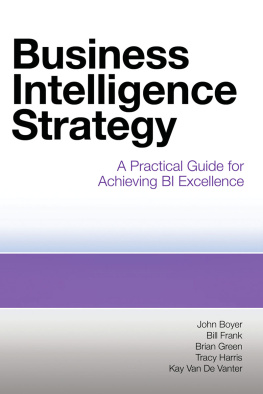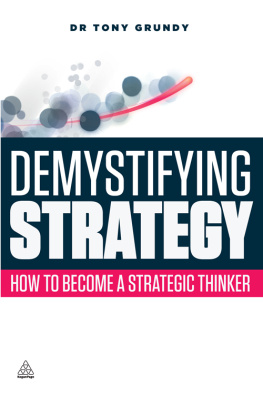To knowledge managers everywhere, in every
organization, industry, and sector on every continent.
May all your strategies be successful!
Thanks to my co-author, Nick Milton. Designing a Successful KM Strategy was his idea and Im so grateful that he asked me to co-author it with him. I learned a lot working with him, and it has truly enhanced my Knowledge Management knowledgeproving that there is always more to learn! Thanks also to Jane Dysart for connecting me to John Bryans at Information Today, Inc., who was just as excited about this title as Nick and I were. Finally, thank you to everyone who has helped me develop my passion for Knowledge Management, whatever role you played.
Stephanie Barnes
Thanks to Stephanie Barnes for her hard work and contributions to Designing a Successful KM Strategy, and especial thanks to Rod Abson for critically reviewing the manuscript and to Dan Ranta for the Foreword. I would also like to acknowledge all the knowledge managers and business people I have worked with over the years who have contributed to the development of the ideas within the book.
Nick Milton
My most recent experience in Knowledge Management came over a 10-year period with a major global oil and gas company. For this international energy company with thousands of job sites (often quite remote) spread across 30 countries, the challenge of sharing knowledge was very realand the potential payoff was huge. Facing fierce competition on all fronts, senior managers realized that to continue on its success trajectory, the company needed to rapidly and effectively harness the knowledge of its highly skilled but geographically distributed workforce. Instead of assuming that technology either was the solution or was irrelevant to knowledge management, senior managers understood that effective global Communities of Practice required new processes, roles, cultures, and technologies. Moreover, they recognized that each Community of Practice had to be focused on solving difficult business challenges, and that the entire Knowledge Management program needed to be based in the business to be successful in the long run.
Ensuring that each individual Community of Practice has the greatest chance to succeed is a process that begins long before the community is formed. Many authors and consultants stress the informal nature of such communities, arguing that any attempt to systematize them will crush them. We found the exact oppositethat without clear and explicit links to the organizational strategy and its business purpose, communities often evolve in ways that fail to contribute to business goals. We developed two fundamental principles in this regard.
Firstly, no Community of Practice was created without a clear and detailed business case that specified the value proposition to the company; community leaders and members agreed upon this business case. Insisting on a business case prior to the creation of a Community of Practice goes against the typical let a thousand flowers bloom approach that is often promoted in the Knowledge Management literature. But in many cases, uncontrolled growth of new communities saps employees attention and engagement, and leads to neglect and community failure. Setting a strategic goal at the outset means that every potential new community must have a strong business justification, which signals to potential leaders and members that the result will not be something that consumes their time without producing real business value. Community members, in turn, see this phenomenon and this drives a higher level of engagement since most employees have laudable amounts of professional pride.
Proposals for new Communities of Practice also clearly had to specify the kinds of deliverables that would be produced through the ongoing operation of the community, and the specific kinds of activities that the community would be supporting. Deliverables (such as research reports and reusable work products) and activities (such as electronic discussions and teleconferences) needed to relate directly to the business case and support the attainment of business strategy. A high degree of focus on these two areas helped separate the wheat from the chaff, leading new community proponents away from fuzzy more is better claims about collaboration and toward specific activities that were likely to produce a solid payoff for the collective investment of time.
Ultimately, managers provided each new Community of Practicethrough its business case, its deliverables, and its activitieswith a clear operating model that connected it to the overall strategy of the business. Following these two principles had a profound effect on the nature and character of communities at this large global company: it aligned them with organizational priorities, helped members understand how they can affect important business goals, provided clear justification for why members should invest their time in the community, and shifted the idea of Knowledge Management away from abstract concepts and toward a concrete set of measurable objectives. As a result, communities became a cornerstone of this companys strategic ability to reach its business goals and deliver additional value through global collaboration and expertise sharing.
The key to getting any Knowledge Management program off to a promising start from a business value standpoint is to strategically address the Knowledge Management opportunities. Knowledge Management should always start with discovering what the business is interested in accomplishing. This is not just the immediate business group or function grappling with Knowledge Management, but also should include alignment all the way to the top of any organization. Alignment creates the opportunity for purposeful collaboration where value can be created and sustained over time. The challenge is often that organizations cannot easily figure out how to set out on a path to create measurable and sustainable value. Smart managers intuitively understand the importance of the problems that Knowledge Management efforts are often designed to address. However, the lack of strategic awareness often results in poorly organized Knowledge Management efforts that are sprinkled across a decentralized construct and not implemented consistently across an organization to ensure standards and best practices are being leveraged with business value in mind.
To ensure Knowledge Management is strategic and linked to business value, organizations need to ensure there are strong relationships between those in charge of implementing Knowledge Management and business leaders. While smart managers can understand how Knowledge Management can support business issues, they cannot get to an intimate understanding where they are ready to embrace Knowledge Management solutions until the necessary work is done to show the linkage between purposeful collaboration and the solution of critical business issues. Knowledge Management practitioners must be able to employ techniques such as those described within this book, to make the connections between Knowledge Management and business value opportunities. This is where the business relationships come into play since it is only with strong relationships that a Knowledge Management practitioner can convince business leaders to try these and other techniques to make these imperative linkages.
Knowledge Management success requires a commitment by management to actively support collaboration so that employees feel that it is part of their day jobs and to ensure a standard means to share with their colleagues. It is possible to design easy and efficient technology-enabled processes that focus on connecting people as part of their daily work, to enable the seamless flow of lessons learned and best practices to the right people at the right time. Showing managers that this approach to knowledge transfer maximizes employees efforts to solve problems is the key. Any corporate culture will always be particularly sensitive to anything perceived to be an additional burden, and one clear sign of Knowledge Management success is that KM activities are not viewed in this manner.
Next page









